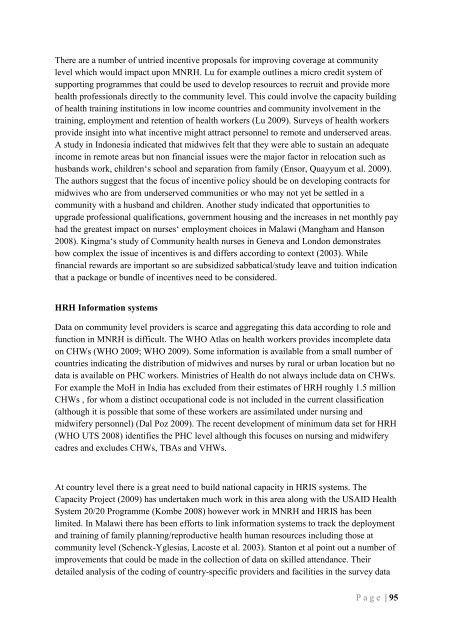Human Resources for Health in Maternal, Neonatal and - HRH ...
Human Resources for Health in Maternal, Neonatal and - HRH ...
Human Resources for Health in Maternal, Neonatal and - HRH ...
You also want an ePaper? Increase the reach of your titles
YUMPU automatically turns print PDFs into web optimized ePapers that Google loves.
There are a number of untried <strong>in</strong>centive proposals <strong>for</strong> improv<strong>in</strong>g coverage at community<br />
level which would impact upon MNRH. Lu <strong>for</strong> example outl<strong>in</strong>es a micro credit system of<br />
support<strong>in</strong>g programmes that could be used to develop resources to recruit <strong>and</strong> provide more<br />
health professionals directly to the community level. This could <strong>in</strong>volve the capacity build<strong>in</strong>g<br />
of health tra<strong>in</strong><strong>in</strong>g <strong>in</strong>stitutions <strong>in</strong> low <strong>in</strong>come countries <strong>and</strong> community <strong>in</strong>volvement <strong>in</strong> the<br />
tra<strong>in</strong><strong>in</strong>g, employment <strong>and</strong> retention of health workers (Lu 2009). Surveys of health workers<br />
provide <strong>in</strong>sight <strong>in</strong>to what <strong>in</strong>centive might attract personnel to remote <strong>and</strong> underserved areas.<br />
A study <strong>in</strong> Indonesia <strong>in</strong>dicated that midwives felt that they were able to susta<strong>in</strong> an adequate<br />
<strong>in</strong>come <strong>in</strong> remote areas but non f<strong>in</strong>ancial issues were the major factor <strong>in</strong> relocation such as<br />
husb<strong>and</strong>s work, children‘s school <strong>and</strong> separation from family (Ensor, Quayyum et al. 2009).<br />
The authors suggest that the focus of <strong>in</strong>centive policy should be on develop<strong>in</strong>g contracts <strong>for</strong><br />
midwives who are from underserved communities or who may not yet be settled <strong>in</strong> a<br />
community with a husb<strong>and</strong> <strong>and</strong> children. Another study <strong>in</strong>dicated that opportunities to<br />
upgrade professional qualifications, government hous<strong>in</strong>g <strong>and</strong> the <strong>in</strong>creases <strong>in</strong> net monthly pay<br />
had the greatest impact on nurses‘ employment choices <strong>in</strong> Malawi (Mangham <strong>and</strong> Hanson<br />
2008). K<strong>in</strong>gma‘s study of Community health nurses <strong>in</strong> Geneva <strong>and</strong> London demonstrates<br />
how complex the issue of <strong>in</strong>centives is <strong>and</strong> differs accord<strong>in</strong>g to context (2003). While<br />
f<strong>in</strong>ancial rewards are important so are subsidized sabbatical/study leave <strong>and</strong> tuition <strong>in</strong>dication<br />
that a package or bundle of <strong>in</strong>centives need to be considered.<br />
<strong>HRH</strong> In<strong>for</strong>mation systems<br />
Data on community level providers is scarce <strong>and</strong> aggregat<strong>in</strong>g this data accord<strong>in</strong>g to role <strong>and</strong><br />
function <strong>in</strong> MNRH is difficult. The WHO Atlas on health workers provides <strong>in</strong>complete data<br />
on CHWs (WHO 2009; WHO 2009). Some <strong>in</strong><strong>for</strong>mation is available from a small number of<br />
countries <strong>in</strong>dicat<strong>in</strong>g the distribution of midwives <strong>and</strong> nurses by rural or urban location but no<br />
data is available on PHC workers. M<strong>in</strong>istries of <strong>Health</strong> do not always <strong>in</strong>clude data on CHWs.<br />
For example the MoH <strong>in</strong> India has excluded from their estimates of <strong>HRH</strong> roughly 1.5 million<br />
CHWs , <strong>for</strong> whom a dist<strong>in</strong>ct occupational code is not <strong>in</strong>cluded <strong>in</strong> the current classification<br />
(although it is possible that some of these workers are assimilated under nurs<strong>in</strong>g <strong>and</strong><br />
midwifery personnel) (Dal Poz 2009). The recent development of m<strong>in</strong>imum data set <strong>for</strong> <strong>HRH</strong><br />
(WHO UTS 2008) identifies the PHC level although this focuses on nurs<strong>in</strong>g <strong>and</strong> midwifery<br />
cadres <strong>and</strong> excludes CHWs, TBAs <strong>and</strong> VHWs.<br />
At country level there is a great need to build national capacity <strong>in</strong> HRIS systems. The<br />
Capacity Project (2009) has undertaken much work <strong>in</strong> this area along with the USAID <strong>Health</strong><br />
System 20/20 Programme (Kombe 2008) however work <strong>in</strong> MNRH <strong>and</strong> HRIS has been<br />
limited. In Malawi there has been ef<strong>for</strong>ts to l<strong>in</strong>k <strong>in</strong><strong>for</strong>mation systems to track the deployment<br />
<strong>and</strong> tra<strong>in</strong><strong>in</strong>g of family plann<strong>in</strong>g/reproductive health human resources <strong>in</strong>clud<strong>in</strong>g those at<br />
community level (Schenck-Yglesias, Lacoste et al. 2003). Stanton et al po<strong>in</strong>t out a number of<br />
improvements that could be made <strong>in</strong> the collection of data on skilled attendance. Their<br />
detailed analysis of the cod<strong>in</strong>g of country-specific providers <strong>and</strong> facilities <strong>in</strong> the survey data<br />
P a g e | 95

















